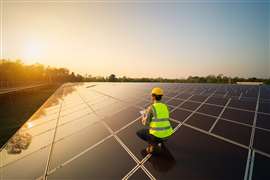What does COP28 mean for construction?
19 December 2023
 Amanda Williams, Head of Environmental Sustainability, CIOB
Amanda Williams, Head of Environmental Sustainability, CIOB
The 2023 United Nations Climate Change Conference or Conference of the Parties of the UNFCCC (COP28) was held from 30 November to 12 December at Expo City, Dubai, United Arab Emirates. To get a better understanding of what the event means for construction we spoke to Amanda Williams, Head of Environmental Sustainability at the Chartered Institute of Builders (CIOB).
Did you attend COP 28? Can you give us a sense of what it is actually like?
Not this year, no. I attended the last two COPs in Glasgow and Egypt. This year our Senior Vice President Mike Kagioglou and some members of our local hub in UAE were on the ground, and I’ve been joining live streamed sessions online. The were some particularly good sessions in the Buildings Pavilion, which I’ve been following closely.
In my experience of attending previous COPs, away from the main negotiations with their headlines, announcements, divisions and compromise, there is a huge programme of events, and a significant amount of collaboration and knowledge sharing happens. As much as it’s great to be involved, I always feel that I must have a compelling reason to travel, due to the carbon impact of the event itself. Last year for example I was speaking as a panellist.
What were some of the main discussion points at the event related to construction?
This COP has been positioned as a global stocktake due to the recent publication of a first comprehensive assessment of progress against the Paris Agreement. So, it’s also time to do a bit of a stock take on where we are for the built environment. The headline for the construction industry is that emissions from buildings have not reduced globally between 2015 and 2022 and those emissions are much higher than they should be if we were on the right trajectory to decarbonise the built environment by 2050. This is according to a preview of the forthcoming Global Status Report for Buildings and Construction, due out early in 2024.
A key initiative was the official launch of the Buildings Breakthrough, which will see countries joining forces to accelerate the transformation of the sector with a view to making near-zero emissions and climate resilient buildings the new normal by 2030. Twenty-eight countries and the European Commission have pledged commitment to the Buildings Breakthrough so far, but an invitation was extended to nations worldwide to unite in this effort.
Similarly, a Cement and Concrete Breakthrough initiative was launched which will aim to make clean cement the preferred choice in global markets, with near-zero emission cement production established and growing in every region of the world by 2030.
There was a call on housing, urban development, environment, and finance ministers to back a Joint Outcome Statement on Urbanization and Climate Change which aims to integrate climate action across all levels of government and accelerate local climate finance.
 The built environment has a key role to play in the path towards sustainability
The built environment has a key role to play in the path towards sustainability
The link between climate and nature was also highlighted with the launch of ‘A Playbook for Nature-Positive Infrastructure Development’. The playbook draws from some of the world’s most important infrastructure projects, to offer a wide range of nature-based solutions that put nature at the heart of infrastructure design.
And there were some great side events in the Buildings Pavilion for Climate Leadership and messages that came from those which resonated with me included the need for more collaboration between Governments and industry, a call to return to simple buildings with climate and culturally sensitive architecture, debate about what we mean by sufficiency, the role of technology, and how we can put purpose back at the centre of the built environment.
Will any regulations for construction come out of COP?
New regulations don’t come directly from COP, but it may be necessary for countries to regulate to ensure they can meet the commitments they’ve made at COP.
If we take the Buildings Breakthrough for example, one area of focus is on the adoption and enforcement of sustainable building codes. In some countries regulations may need strengthening to provide the framework needed for this enforcement for example.
The next steps under the Buildings Breakthrough include a meeting of ministers with responsibility for buildings and construction next March in Paris, where priority actions will be agreed to drive progress. So, I guess it’s a case of watch this space.
What is clear coming away from COP28, is that policymakers must embrace the role of the built environment in this transition and leverage on its potential to make a significant contribution.
What are some ‘easy wins’ that construction could employ to reduce its emissions?
I don’t really like using the language of easy wins anymore if I’m honest. We need to face up to the fact that addressing the climate emergency is going to require us to take some difficult decisions, make significant investments, and get to grips with some complex issues. Incremental change has enabled us to make some progress, but not at the pace and scale that we really need.
That said, I guess one thing that is an easy win, with the potential to have a significant multiplier effect is that everyone in construction (both at individual and organisational level) can start to work on knowledge development. There is a shortage of skilled workers in construction, and a particular shortage of people with sustainability knowledge and green skills, so whatever your role is in the industry (because don’t forget we all have a role to play in this transition) why not make sustainability an area for some focused learning in the coming year.
If we’re not developing sustainability knowledge in our teams then we’re not preparing people to operate effectively in an industry that needs those skills, and a jobs market that is going to demand them.
 Buildings are responsible for almost 40% of global energy-related carbon emissions
Buildings are responsible for almost 40% of global energy-related carbon emissions
Is the data accurate enough when it comes to recording carbon emissions for construction?
I think the short answer to that is probably no, but it is improving. The ability to accurately define, measure, and verify that a building’s construction and operation is in line with net zero is going to be essential to the industry. One of the challenges has been a lack of clarity, or different understandings, of what we mean by a net zero building, and a lack of standardisation in how we measure this.
Lots of construction-related companies have made sustainability pledges – has it shifted from a ‘nice to do’ to an essential?
You know, buildings are responsible for almost 40% of global energy-related carbon emissions – and their operational emissions grew year on year from 2015 to 2021 by an average of 1%, even though the Paris Agreement requires us to halve these emissions by 2030.
The built environment, and the construction industry specifically, is central to a green transition, and there is a need for meaningful action, clear government oversight, and a cohesive set of measures to address carbon emissions throughout the design, construction, and operation of the built environment.
This was never a nice to do, it is absolute essential, and the businesses that lead on this will be the ones that will be the most successful in the future.
We can’t spend another 30 years making progress in small incremental steps. We need to accelerate our efforts, and the built environment has a key role to play in this transition.
STAY CONNECTED



Receive the information you need when you need it through our world-leading magazines, newsletters and daily briefings.
CONNECT WITH THE TEAM








